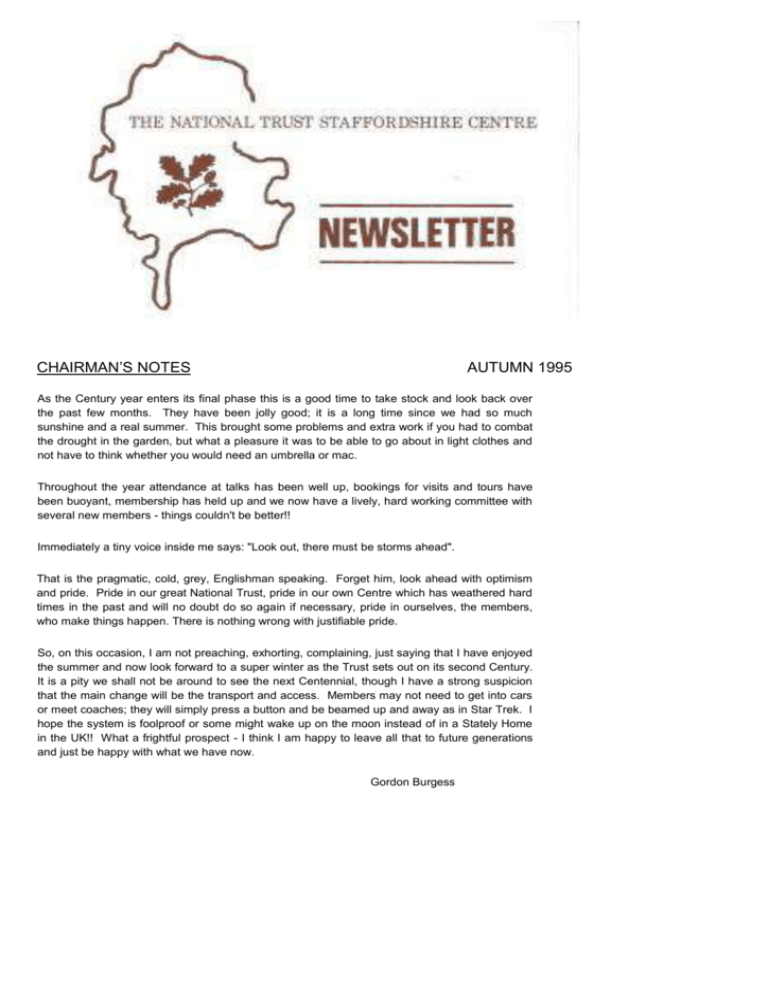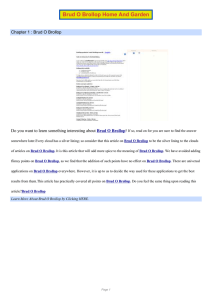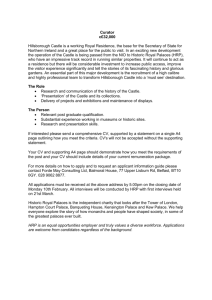Autumn 1995
advertisement

CHAIRMAN’S NOTES AUTUMN 1995 As the Century year enters its final phase this is a good time to take stock and look back over the past few months. They have been jolly good; it is a long time since we had so much sunshine and a real summer. This brought some problems and extra work if you had to combat the drought in the garden, but what a pleasure it was to be able to go about in light clothes and not have to think whether you would need an umbrella or mac. Throughout the year attendance at talks has been well up, bookings for visits and tours have been buoyant, membership has held up and we now have a lively, hard working committee with several new members - things couldn't be better!! Immediately a tiny voice inside me says: "Look out, there must be storms ahead". That is the pragmatic, cold, grey, Englishman speaking. Forget him, look ahead with optimism and pride. Pride in our great National Trust, pride in our own Centre which has weathered hard times in the past and will no doubt do so again if necessary, pride in ourselves, the members, who make things happen. There is nothing wrong with justifiable pride. So, on this occasion, I am not preaching, exhorting, complaining, just saying that I have enjoyed the summer and now look forward to a super winter as the Trust sets out on its second Century. It is a pity we shall not be around to see the next Centennial, though I have a strong suspicion that the main change will be the transport and access. Members may not need to get into cars or meet coaches; they will simply press a button and be beamed up and away as in Star Trek. I hope the system is foolproof or some might wake up on the moon instead of in a Stately Home in the UK!! What a frightful prospect - I think I am happy to leave all that to future generations and just be happy with what we have now. Gordon Burgess NEW MEMBERS We are pleased to welcome the following new members who have joined the Centre since the Summer issue of the Newsletter. Mrs P.Lawrence, Miss A.M.Phillips, Mrs A.Wilford, RAMBLES AND AMBLES Sometime ago we made a plea for new leaders of rambles or ambles. Unfortunately there was no response. But as we are now very short of leaders perhaps there is someone out there who is willing to plan and check a walk and share the pleasures of their enjoyment with others. Anyone interested should contact me or any Committee member. Cliff Ricketts NOTES FROM YOUR MEMBERSHIP AND BOOKINGS SECRETARY Once again I have managed to cope with a flood of paper, changed arrangements and not a few queries. In January we shall be sending out the spring programme and the invitations to renew your membership of a successful Centre. Prompt renewals are a great help - it reduces the number of reminders. Please remember to date your cheques for 1996 - last winter I did not have a single "out-of-date" one. A very good record. Despite the recent change in the booking form, I am still getting too many without details of pickup point (some of which I can guess), and even names. So, we shall make another change and next time you will find the following box to complete: PLEASE COMPLETE THE APPROPRIATE BOXES P I C K U P P O I N T STAFFORD TOTAL WALTON NAME RUGELEY TEL. No. LICHFIELD COFFEE VOLUNTEER "OH, DEAR! WHAT CAN THE MATTER BE?" "Two old ladies locked in the •••••• NO! •••••• Tower of the Winds!!!" On Bank Holiday Monday, 28th August, two of our lady members on their way down from the upstairs room of the Tower of the Winds at about 4.30pm discovered, to their horror, that the exit door of the building had been locked. By then, of course, most visitors had left the area and the prospect loomed of having to open, or even break, windows to climb out - a most undignified procedure, especially for respectable lady members of the National Trust! Fortunately someone passed sufficiently close to the building to be attracted by frantic shouting and banging on windows from within and brought succour to our two friends. MORAL - to all volunteers who man the Tower of the Winds - well, it's obvious! REFRESISHMENTS Mrs Burgess would like to thank all the members who so very kindly offer to serve tea and coffee at the lectures. It is obviously not necessary to call upon all the volunteers at anyone time, so if you have not yet been approached, please keep ticking the boxes; your turn will come! An umbrella was left behind in the Walton Village Hall after the talk on Silver on Thursday, September 7th. Will the owner please ring 01543 472025. THE CHRISTMAS LUNCH Bookings for Christmas Lunch are coming in, but we still have places available. This year I must have all bookings please by MONDAY 4th DECEMBER. If you have queries after that date will you please telephone: MR L.ASHTON - 01785 663950. …………………………………………………………………….. A MEMBER'S RECOLLECTION OF THE PAST It was thrilling to receive a ticket to participate in the Service and Parade, which marked the ending of the Second World War. I decided after some consideration, to parade as a non-marcher and consequently to stand in the Forecourt of Buckingham Palace and be reviewed by the Queen. Lining up in Birdcage Walk, whose trees provided plenty of shade, there was a chance to talk to the officer and soldiers of the Grenadier Guards, in charge of the Review veterans. It was necessary to realign the Royal Navy personnel before marching off; but the officer assured us that, as we were the Senior Service, we would be in the front. So out into the heat and crowds we marched, keeping our eyes on the boots of the Grenadiers leading us along the road, through the Palace gates and across the Forecourt, surfaced by gravel and needing therefore a slower pace; to our Review position. From there we could easily see the Royals and religious leaders gathering and subsequently hear the service most clearly. What a simple, stirring event that was. A special silence prevailed as Viscount Slim, President of the Burma Star Association read, in measured tones, the Kohima Epitaph and Vice-Admiral Dalton, President of the Royal British Legion, in a like manner, read Lawrence Binyon's ‘For the Fallen’. Then a Lancaster bomber flew along the Mall and over the Palace, releasing the petals of a million poppies in Remembrance. Following the service the Queen and the Duke of Edinburgh returned to the Forecourt of the Palace to review the non-marching veterans. The Queen stopped and talked to many. I feel greatly honoured that she also stopped and spoke to me. Passing behind she spent time with the Far Eastern Internees and P.O.W’s. prior to moving to the Mall for the Parade. A long time was spent in the Forecourt, during which we were well looked after by the Grenadiers. Chairs were offered; water was provided. It was very hot and the Grenadiers had been in their uniforms with bearskins, since eleven o'clock. May I say how proud I am to have served in the WRNS in World War Two, to have been able to honour all those who also served and to remember those who did not return. I am sure other ex-WRNS participating in the Tribute and Promise Service and Parade, whether seated or marching, share my feelings. I end with the Kohima Epitaph, which was spoken in all the VJ weekend events. "When you go home, tell them of us and say: For your tomorrow, we gave our today." Muriel Lightfo THE CENTENARY GARDEN PARTY AT BUCKINGHAM PALACE A DAY TO REMEMBER Fortunately Angela and I were able to spend the night before at my sister's in London - unlike many of the guests who had to endure long distances on a train or coach on the day itself all dressed up in their fineries! The large "X" on our windscreen ensured that we were gently guided to a parking space in the Mall by a courteous bobby, from where we made our way to the Palace on foot. It was a magnificent day and, perhaps a little guiltily, we stalked past the hoi poloi who gazed at us enviously as we moved towards the Royal Presence. Our first impression of the garden was of a vast lawn (somewhat dried, I’m afraid) with marquees discreetly disposed on either side, a "diplomatic" one on the right and a general one on the left. In the distance glittered a beautiful lake set in woodland, the whole 40 acres of garden/surrounded by great trees and herbaceous borders abounding in flowers. The sense of privacy, in the heart of London, is complete - except for one gross and insulting intrusion in the form of a huge multi-storey hotel a few hundred yards from the Palace, the top ten or fifteen floors of which "enjoy" an uninterrupted view of the whole garden. Some idea of the size of the lawn can be gleaned from the fact that two bands, stationed at more or less opposite points of the garden, were playing different tunes simultaneously without noticeable cross-talk! Certainly none of the 6000 of us who swarmed through the Palace and fanned out on the lawn suffered any sense of congestion. The same could not be said of the tea marquee, but I'm happy to say we all behaved impeccably while queuing for the scrumptious tea! At four o'clock sharp the two bands struck up the National Anthem to announce the arrival of Her Majesty the Queen and HRH Prince Charles, and for the next hour and a quarter the Royal Pair processed between four phalanxes of guests and chatted amicably to members of the crowd. Angela and I got very close but we weren't among the lucky ones. At least the Prince waved cheerily at us before he and his mother disappeared for their tea in the diplomatic marquee! We took the opportunity of touring the lovely lake until six o'clock, when once again the bands struck up the Anthem and the Royal Pair re-appeared and very slowly returned to the Palace between rows of gorgeously attired beef-eaters. So ended a truly enjoyable and unique experience. By remarkable coincidence we did, in the course of the afternoon, bump into all three members of our Centre who attended the party accompanied by their charmingly dressed wives. Guy de Visme …………………………………………………………. SWALLOW HAYES GARDEN AND WIGHTWICK MANOR It was glorious mid-summer sunshine all day when we visited Swallow Hayes Garden and Wightwick Manor on 22nd June. We arrived at Swallow Hayes shortly after ten to be met by the friendliest of welcomes by Mrs Edwards wearing her "gardener" badge. "You can only be a Head gardener if you have assistants" she explained. Soon she plied us with tea and assured us that she was happy to answer questions. There were many and she impressed, not only by the extensive knowledge, but also by her unfailing patience and cheerfulness. The garden was a delight and two hours hardly seemed enough time to fully appreciate it all. At first the tendency was to explore moving from one area to another charmed by the general effect of trees, shrubs, lawn and herbaceous plants. Among the features which particularly caught the eye were the Well with its wonderful collection of ferns, "Yew Tree Cottage" - a child's house formed from clipped Yew and a striking use of climbing plants, chiefly Clematis and Roses. The Rhododendrons, Azaleas and Laburnum tunnel reminded us that the garden must be as lovely a place in early Spring as it is in high Summer. Our guide for the tour of Wightwick Manor, a Victorian-built Tudor style Manor House, was splendidly informative. The furniture is impressive as is the interior decoration with its panelling, William Morris Wall-hangings, Murals and fine plaster ceilings. There is a collection of preRaphalite paintings, their Victorian sentimentality once so out of fashion, but the quality of the painting and use of colour now gaining the recognition it has always deserved. Altogether it was a great day out, extremely well organised and providing wonderful sights. The writer left the coach at the end of the outing both shaken and stirred, - stirred by what he had seen and shaken by the bumpiest coach ride for many a long day! Many thanks to the organisers. Edmund Hardwick ................................................... EASTNOR CASTLE Phew: Yet another torrid day for our outing to EASTNOR CASTLE on the 17th August, through parched countryside with its expanses of coconut matting where we expect the cool look of green grass, and the sad appearance of young trees dying, especially our graceful, silver birch. Our full coach taking us to the Castle in the heart of the Malverns, was cool compared with outside temperatures - a welcome change from feeling one was entering an oven. Eastnor Castle is well situated to afford fine views over the lake and arboretum and presents a fairy tale image, with its many turrets and solid sandstone walls, quarried from the Forest of Dean, which is as well for it was always intended as a home, not a fortress. It was built by the first Earl Somers, between 1810-1824, to assist his family to join the ruling classes. The present owners who are resident, have overseen a great deal of restoration and redecoration, before opening their home to the public this decade. The Great Hall named for its unusual height as well as its vastness of floor area and the Gothic drawing-room with its warm colours, fan-vaulting features and Brussels tapestries, were my favourites. Some of the bedrooms seemed oppressively dark, but I enjoyed most the many rich tapestries indoors and the magnificent trees outdoors, whilst rambling in their welcome shade around the lake. Our journey there and back was pleasantly straight forward and our thanks go to Mr and Mrs Boote, for another entertaining Trust excursion. Audrey Williams ………………………………………………………….. BLACKLADIES Approximately forty members arrived at Blackladies near Brewood in time for a walk round the gardens. How do you begin to write down an impression of a truly fascinating afternoon? We all admired the exterior of the fourteenth century building, built with warm red bricks and interesting chimneys. Mrs Bywater greeted us at the door and directed us up a beautiful staircase to a comfortable lounge. Mr David Bywater gave us a background talk and slides about the Brewood area where the Romans had settled, and later the Normans. It was the Normans who built a convent for Benedictine Nuns who wore black habits, hence the name Blackladies. When Henry VIII dissolved the monasteries, Blackladies was bought by the Gifford family of Chillington. It remained in the Gifford family till the end of the last century. The house passed through only two other families before the Bywaters bought it. Eighteen years ago, a lucky chance of seeing an advert in the Times brought them to view it. They felt they had to live there. At this time, the property was divided into two dwellings. The Bywaters began a careful restoration of the part they owned. Eventually they were able to purchase the other section. Many hours of thought and work have obviously bee put into the building. There is wooden panelling in three of the rooms. Many of the fireplaces are of Coalport designs with English Delft tiles. In a modern bathroom we were shown an original garderobe, complete with its beechwood seat. There are only two garderobes to be found in Staffordshire. Every room is furnished in a manner which is in keeping with the lovely old house and the result is a welcoming, homely atmosphere. After our delight in walking round, we were given the sumptuous tea we had been promised, rolls, home made cakes and scones with cream and jam. For a most successful and happy time our thanks go to Mr and Mrs Bywater and Roher Hall for arranging the afternoon. Jean Caldwell Maureen Batty …………………………………………………………………. CHATSWORTH ESTATE RAMBLE It was a glorious morning in the midst of the July heat-wave, when Cliff’s group congregated at Calton Lees car park. We were about 20 adults, 2 dogs (Corrie and Fennel), and 2 children (Joe 10 & Hanna 6). Our first landmark was an old Mill which looked more like a Victorian folly than an erstwhile working Mill. We continued across a field which sloped down to the banks of the River Derwent and it was there that Barry, deep in conversation with Denis, found his foot deep in the freshest cow pat in the field. Denis got the blame and the party moved a little further way from them both! Our route took us up a narrow lane (the beginning of the 500ft climb which Cliff warned about), to Besley Hiltop Farm where there was a splendid collection of mushroom shaped, carver staddles. Hayrick supports of this type were mentioned by Thomas Hardy in ‘Far from The Madding Crowd’. We turned then to climb up a track through bracken. It was steep-sided, airless and very, very hot so we were all grateful to reach the top where there were wonderful views and a cool breeze. We could see the village of Edensor in the distance which was to be our longer, afternoon route. Would we have the energy I wondered? It was a pleasant and easy walking in the shade of Stand Wood past Swiss Lake and on to Emperor Lake where we had our coffee stop sitting on a fallen tree trunk. (Cliff thinks of everything). Hannah and Joe paddled, the dogs swam and the rest of us looked on longingly. A short distance on, we took a closer look at Hunting Tower, a mid 16th century look-out from the time of Sir William Cavendish and his wife Bess of Hardwick. Now a private house it has a wonderful birds eye view over Chatsworth House and Park. Onward and downward (oh joy!). Through the wooded scarps to the deer park where we could see, not deer, but tents galore. This we found out, was Peak ’95 Scout Jamboree. These tents looked much more sophisticated and civilised than the old khaki bell-tent jobs I remember from my youth - but Then, That was many years ago' We continued through the kissing gate and out of Chatsworth Park for a while, to Baslow, passing a delightful cottage with double decker window boxes overflowing with Petunias and a border ablaze with Mesembryanthemums, ("Miss Henry Anthems"). After lunch, through Chatsworth Park and back to our waiting cars. Only Hannah and Joe still had a spring in their step by then: .......................................……………............. Beryl Freeman OUR WEEKEND IN NORTHUMBERLAND One of the four Wallington "Monsters". Big Chief Gordon and his Sheila, led us to the promised land: North of Humber, Penrith first, for lunch to eat and shop around. Busy, busy market town, ancient red-stone buildings then were left behind for quaint Hexham. The Abbey church was our main aim though old King Henry caused much pain Abbey and Priory in part remain, Saxon and Norman relics famed. Mr Fox's joy was in the Crypt, a Roman ploy of stones engraved, with Marcus's murder of Geta depraved. Where'er the Roman Empire based, every mention of Geta erased. Next to Alnwick to take our rooms in the old White Swan, whose claim to fame was elegant panelling in the dining room, torn from Olympia, sister of Titanic instead of the sea it came to Alnwick. Bamburgh Castle was next on the tour now the Armstrong's but previously Edwin and Oswald held the key. The Great Hall's roof is carved in teak, Panelling and paintings are all unique, the one that dominates is 'The Cheat'. Grace Darling's grave and Museum, are found in the village if you look for them. Her daring exploits inspired us all. She must have been brave to answer the call. We learned about her at Junior School. Oswald from Bamburgh to Lindesfarne went, we did too. A message was sent but on keeping us out the NT was hell-bent. The Priory was plundered to build the Castle when, Henry the Eighth was active again. Fishing for herring was no longer viable so boats upside down became store sheds reliable. The peak of our tour was Cragside for sure, showing Armstrong's allure. Innovation and knowledge combined to produce a magnificent house of fame and repute, surrounded by naturalised gardens to suit. We reluctantly left for Wallington Hall to view the pre-Raphalites, dolls' houses and all. The gardens were beautiful but we felt sad that Cragside was left and we hadn't had more time to enjoy all Armstrong's fads. At Housesteads next day we called on the Romans, to look at their fort, with mod cons and granary. The altar to Mithras was just up the alleyway. Devotional gifts ensured the sun shone. When Gordon was missing he'd obviously gone, to bow to Mithras for everyone. Blanchland on Derwent was no mean feat. We now know the secret: Lord Crewe Hotel was the ‘white’ Monks retreat (though one of the graves was female and neat). Time prevented a better look round but, the meal that we had was delicious with sweet. We thank Gordon and Sheila for bringing us back and for planning the holiday without use of mac. Jean and Joe Wootton ……………………………………………………………………………………………………………… ……… FROM: J.E.KING 7th September 1995 Dear Mr De Visme, As soon as I got back home I thought that I better dig out the photographs in case I forgot your request. They are colour, unfortunately, but near enough to be black and white, so they may fill the bill. The details are in pencil on the reverse of each photo and I would be grateful if you could return them in due course as they would be useful in the event of a burglary! The Payne & Son Sheffield 1977 mark (shown opposite) is the most distinct, and of interest, as it has the new Assay Office mark - the Yorkshire rose and the Sovereign's head as an optional mark for the Silver Jubilee. Previously the Assay Office mark was the crown but changed under the 1973 Hallmarking Act. Yours sincerely, John E.King P & S Payne & Sons (Oxford) Sheffield - Yorkshire Rose Lion Passant - Stirling Standard Date letter C 1977 Queen Head - Jubilee mark …………………………………………………….. 700 YEARS OF SILVER: AN HISTORICAL & SOCIAL REVUE Silver and gold were the two most precious metals. Silver is much cheaper than gold because of availability. The silver Hallmark was started in 1300 even though silver was in circulation before. The first Hallmark was a lion's head. The origin of the term 'Sterling Silver' probably evolved when King John called in the Easterlings (German Silversmiths) to authenticate the quality of his silver. Political, Social and Fashionable changes have meant that a lot of old silver pieces have been melted down and re-used so there are not many examples say from The Reformation or from the Cromwellian period. Fashion is said to have caused more mischief than Revolutions. To keep up with the Jones’s many households had pieces refashioned or transposed into coinage when times were difficult. Gilding of silver became very fashionable perhaps to imitate gold but, this was before Health and Safety at Work regulations were introduced. Because Mercury was used in this process at the Hatter Institute, the fumes given off greatly affected the workers. They became mad and this is where the term 'As mad as Hatters' originated from. Mr King gave a very interesting and informative talk with a good quotation to finish: 'Today's heritage is the creation of yesterday and the creation of today, is the heritage of tomorrow.' Jean Wootton ………………………………………………………………………………………………………. From: R.W.G.Smith 11 .7.95. Dear Mr Tanner, Thank you very much for your letter and enclosure. I am pleased that my talk about Plardiwick gave so much pleasure. The object, of course, was to show how much history can be found in an apparently insignificant area, though whether it would justify a National Trust outing I rather doubt it! There is one small detail in the report which is incorrect. The order at St Evroul in Normandy was not a Carthusian order. It was, I think, Benedictine. The Carthusians first came into the picture, so far as Plardiwick is concerned, in 1415 when the King, on closing alien houses, redistributed their lands and gave Plardiwick, among others, to the Carthusian priory at Shene, Richmond. Your correspondents refer to the sixteen spellings of the name, and they might like to know what they are, so I give them below: Plardiwick Plardwick Plaidiwick Plardwicke Plardewick Plordwecke Plerdewirke Plerdewicke Plerdewike Plodwick Plardewyck Plerdewyck Plordewycke Plordswicke Plardwycke Plardewyck There are no doubt others to be found. With best wiches, Ronald Smith ........................................ THE FOLLOWING WAS A LATE INSERTION IN THE AUTUMM NEWSLETTER THE NATIONAL TRUST STAFFORDSHIRE CENTRE WILFRED POVEY It is with sorrow and a sense of great loss that I have to report the death of our former Chairman, Mr. Wilfred Povey on Friday, 13th October 1995. Wilf, as he was affectionately known by all of us, was a member of the steering committee which brought the National Trust Staffordshire Centre (our Centre), into being on Tuesday, 27th March 1973. Serving on the committee from then on, it was largely due to Wilfs efforts that the Centre prospered and grew despite periodic difficulties. In this he was ably supported by his wife, Meg, who was also on the committee. Wilf took over as Chairman in 1976 and for the next 15 years it was his foresight, integrity and steadfastness which enabled the Centre to go from strength to strength in its support of the National Trust. This was made even more remarkable by the fact that during this time he faced a personal tragedy when his wife, Meg, died. Lesser men would have faltered, but not Wilt. During his time as Chairman he led from the front; he was a regular organiser of talks, visits and holidays, all setting very high-standards! For this alone he will be remembered and missed by many members. After handing over the Chairmanship in 1991 he did not sit back and watch others working; he stayed on the committee and extended his activities by producing our first overseas visits, initially to Normandy and then to Burgundy. Finally, earlier this year he took a group to Scotland for a holiday. Wilf loved Scotland, perhaps because it reminded him of the country of his birth, New Zealand. Our condolences go to his daughters Anne and Jackie and their families together with out gratitude for sharing him with us. Wilf dedicated the last years of his life to the National Trust through this Centre and I can say with absolute certainty that he would not wish us to mourn in sadness too long. He would want us to carry on with the task which he started and that, surely, would be the most fitting tribute we could pay to him at this time. We have lost a good friend and counsellor whose enthusiasm will continue to inspire us in the future. He will be greatly missed but never forgotten, for his spirit will live on in this Centre which he did so much to foster. Thank you Wilf - Rest in Peace. 15 October 1995 GORDON BURGESS Chairman.







